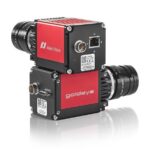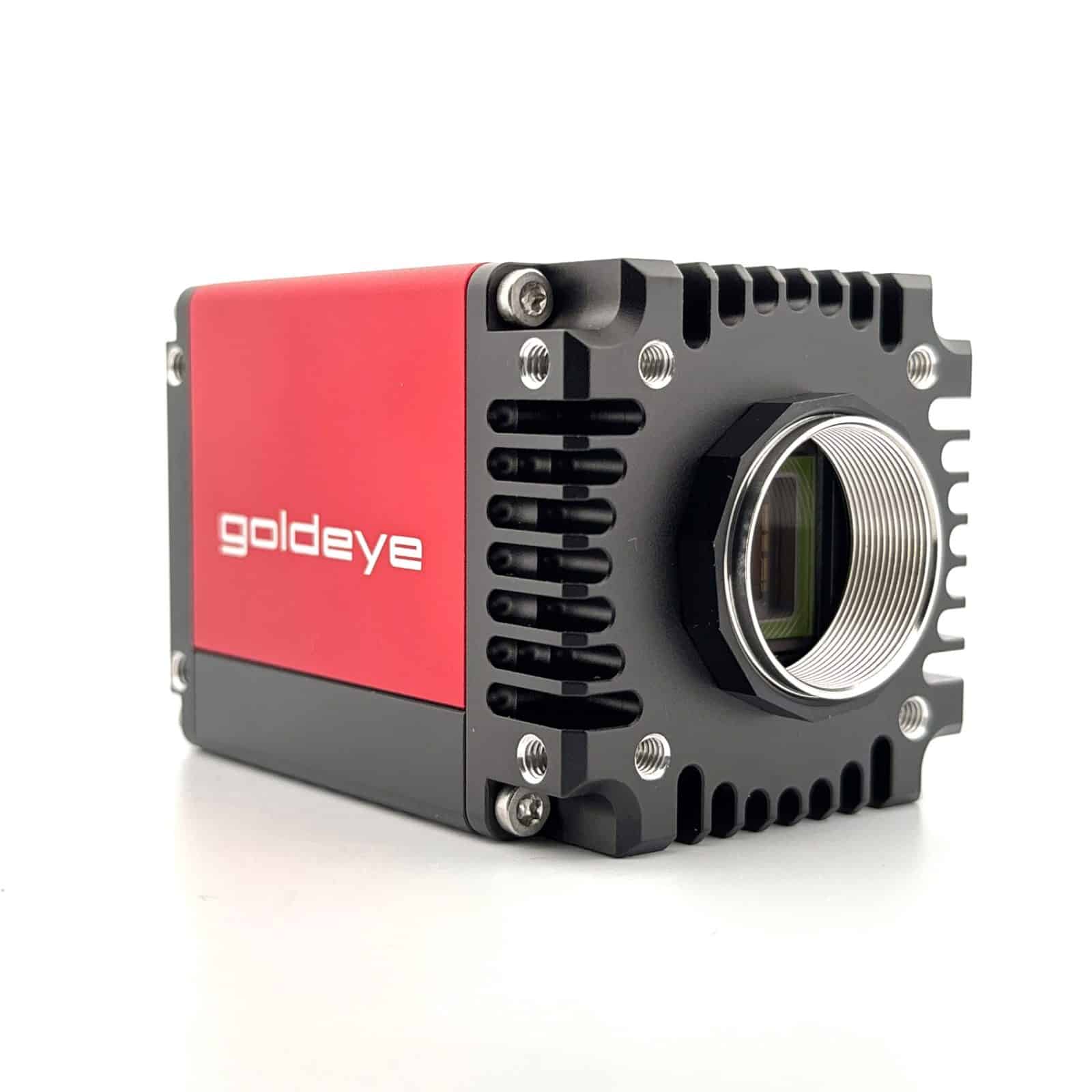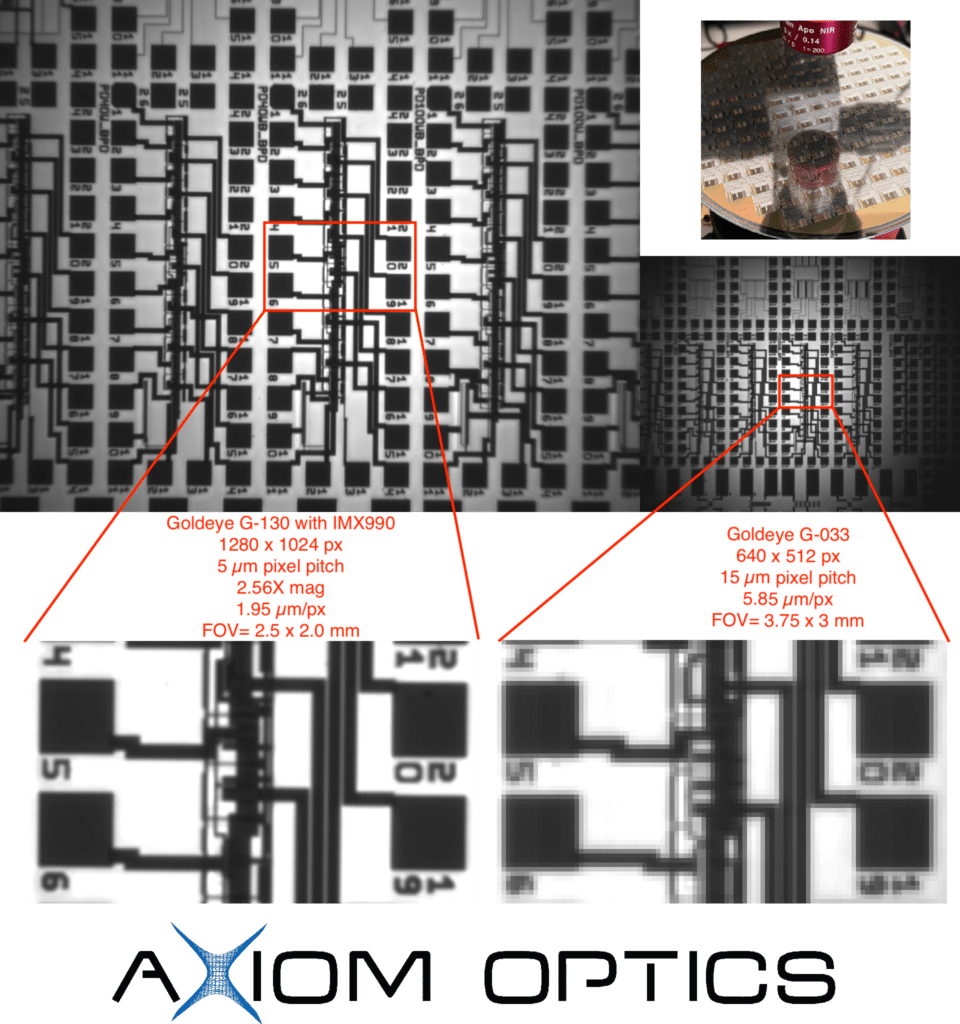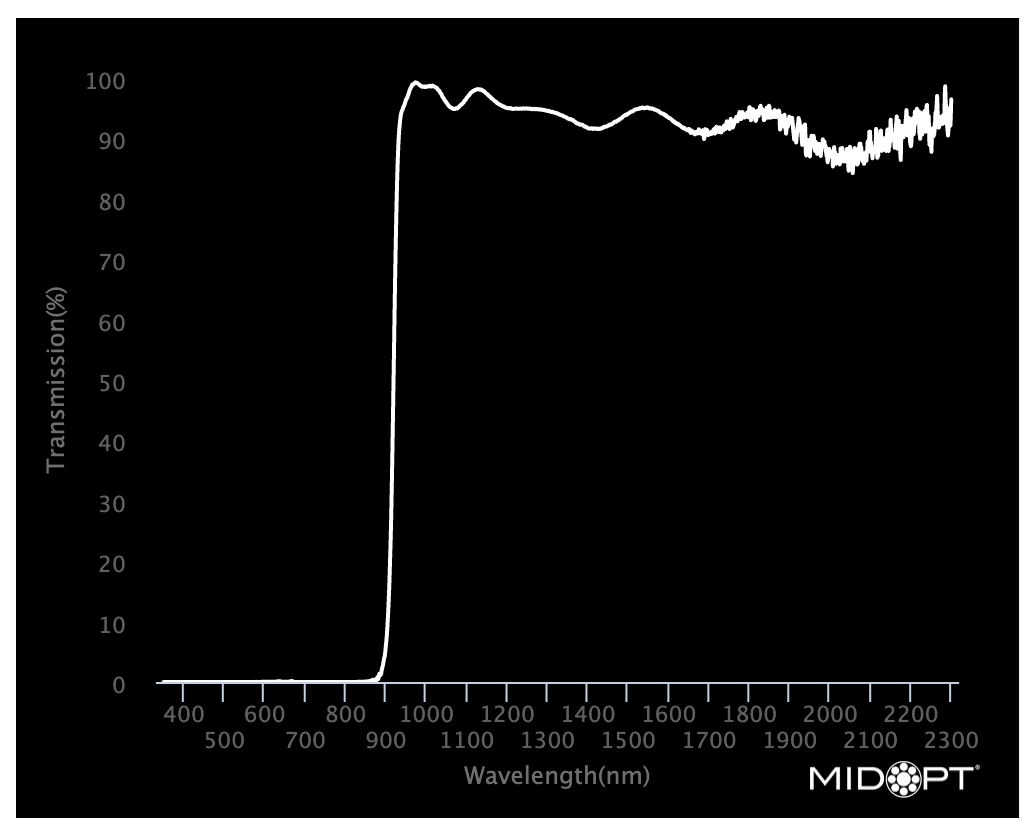Megapixel InGaAs resolution with sensitivity in both the visible and short-wave infrared
Discover 4 new Goldeye VSWIR models with the SenSWIR-InGaAs sensors by Sony (IMX990 and IMX991). 1.3MP resolution and VGA resolution with 5µm pitch, VIS-SWIR sensitivity and high QE unlocks many applications. GigE ethernet and CameraLink interfaces available.
Improvements brought by the SenSWIR sensor (IMX990 / IMX991) technology by Sony
-
Visible spectral range extension (400nm – 1700nm)
Sony SenSWIR InGaAs sensors are designed with a very thin Indium Phosphide (InP) layer enabling visible light to pass through to the sensitive InGaAs layer. There are already InGaAs sensors available on the market with visible light extension, but Sony is the first manufacturer who managed to keep the quantum efficiency over the full spectral range at a relative high level (>50%). In some applications (e.g. spectral imaging, surveillance) this can help to reduce system costs as only a single camera needs to be used.
-
Higher inspection precision (5µm pixel pitch)
By using Copper-to-Copper connections between the indium-gallium-arsenide (InGaAs) photodiode layer and the silicon readout circuit layer instead of Indium bumps, much smaller pixel sizes of only 5µm² can be realized. This enables imaging with high spatial resolution to reveal smaller object details.
-
High image homogeneity
The Sony SenSWIR IMX990 & IMX991 sensors are the first sensors we have integrated into the Goldeye camera series with digital outputs. Previous analog sensors require external ADCs resulting in the typical visible vertical striped that are corrected by our NUC.
In addition, the high image homogeneity of Sony SenSWIR sensors is supported by the Copper-to-Copper connections, that Sony is using in their stacked design, to connect the InGaAs layer with the Silicon Readout IC. They ensure a much more reliable and uniform connection between the two layers vs. existing solutions using Indium bumps. -
Easy spectral filter integration
Sony SenSWIR sensors are comparatively small. Even the SXGA sensor has only a size of 1/2”. Therefore, the F- and M42- Mount options of the Goldeye’s modular concept are most-likely not relevant, so we decided to change the mount concept for the G-130 and G-030 to be the same concept as the Prosilica GT. This enables the user to screw in standard C-mount filters easily and reduces overall costs.
Sony SenSWIR key features
Smallest pixel pitch of 5 microns in the industry


Thermoelectric cooling for increased image quality
Allied Vision will release four Goldeye camera models with the new SenSWIR-InGaAs sensors. As usual, the cameras will be available with GigE Vision or CameraLink interfaces to meet as many different system requirements as possible. The Goldeye G/CL-130 with IMX990 1.3MP SXGA sensor offers a frame rate of 110 fps (with CameraLink interface) or 94 fps (with GigE Vision interface) and the G/CL-030 features the ¼ inch VGA sensor IMX991, which enables interface independent a frame rate of 258 fps.
All new camera models feature a robust and compact design optimized for industrial applications without fan. The integrated single-stage sensor cooling (TEC1) and several integrated image correction functions will contribute significantly to the excellent image quality. The comprehensive I/O and GenICam standard compliant feature control options also considerably simplify the system integration of Goldeye cameras.
Allied Vision – The SWIR camera expert
Allied Vision has many years of experience in the development of short-wave infrared cameras with InGaAs sensor technology. The current product portfolio includes models with QVGA and VGA resolution with and without thermoelectric sensor cooling. For scientific applications, cameras with two-stage thermoelectric sensor cooling (TEC2), nitrogen cooling chamber and fan are also available, which enable particularly low-noise image acquisition with long exposure times. With this comprehensive expertise, Allied Vision provides optimized cameras with outstanding image quality in terms of homogeneity, dynamics, and linearity for a wide range of applications. The high quality of Goldeye VSWIR cameras is emphasized by a 3-year guarantee, which is unique for SWIR cameras in the market. The ease-of-use of Goldeye cameras provides an unmatched out-of-the-box experience.
IR-specific features (camera and sensor)
- Integrated correction data sets, compensation of sensor inhomogeneity and underlying structures (non-uniformity correction – NUC)
- Defect pixel correction
- Background correction
- Automated and manual sensor temperature management via TEC features
- Temperature status indicator
- Temperature specific events
General features of Goldeye VSWIR G-130/-030
- Automatic exposure time control
- Gain (analog)
- I/O configuration and trigger control
- Stream hold (deferred image output)
- Storable user sets
- Firmware update in the field
- Region of interest (ROI) control, look-up table (LUT) support, as well as various auto features
- Auto-Black Level Adjustment
This feature reduces the dark current and is permanently active in the Goldeye G-130/030 VSWIR cameras. - Multi-ROI (up to 8)
Applying this feature is increasing the frame rate and is especially useful for spectral imaging applications to select certain wavebands. - Short Exposure Mode
We achieve currently 16µs/18µs (G-030/G-130) as minimum exposure time. The Short Exposure Mode will enable exposure times potentially as low as 3µs to prevent image blur when imaging fast moving objects.
Perfectly connected – thanks to a powerful software suite
Have you heard of Vimba, our future-proof and platform independent SDK (software development kit)? Thanks to our in-house software you can easily integrate Goldeye VSWIR cameras with GigE Vision interface into any system and manage them centrally. Vimba runs on Windows, Linux, and Linux for ARM. With Vimba, you can acquire images and control your Allied Vision camera instantly, program complex vision applications or connect to third-party libraries. Goldeye VSWIR cameras with Camera Link interface can also be configured easily via Vimba SDK. To capture/stream images you have to use the frame grabber SDK.
Learn more about the Goldeye cameras
Learn more about SWIR applications
Goldeye VSWIR applications
Visit our SWIR application page now!
- Military / Defense (Imaging at long ranges and through obscurants (fog, smoke, mist, haze, rain…), Border security, Rocket missile tracking)
- Security & Surveillance
- Semiconductor inspection
- Photovoltaics (Electroluminescence for PV cells)
- Spectroscopy
Laser beam profiling with RayCi software:
- Laser beam analysis of CW and pulsed lasers
- Alignment of lasers in production
- Quick control of laser modes and adjustment errors
- Near-Field and Far-Field analysis of lasers
- Laser beam quality measurement M2
VIMBA SDK for Goldeye VSWIR
Vimba is a comprehensive software suite:
- Acquire images and explore camera features without programming.
- Program your vision applications with C, C++, .NET or Python APIs.
- Connect to third-party libraries and frameworks.
Platform independent
Vimba 6.0 was tested with:
- Vimba for Windows 64-bit:
- Windows 10 (GigE, USB, 1394, and Camera Link cameras)
- Windows 11 (GigE, USB, and 1394 cameras)
- Vimba for Windows 32-bit:
- Windows 10 (GigE, USB, 1394, and Camera Link cameras)
- Vimba for Linux: Ubuntu 20.04 LTS (64-bit), Debian 11.2 (64-bit)
- Vimba for ARM64: NVIDIA Xavier NX with
- JetPack 4.6 (L4T 32.6.1) – GigE and USB cameras
From quick prototyping to sophisticated development
Vimba provides four APIs with extensive documentation and code examples:
The Python API is perfect for a quick and easy start or for prototyping.
The C API is Vimba’s basic and easy-to-use API. It can also be used as API for C++ applications.
The C++ API has an elaborate class architecture. It is designed as a highly efficient and sophisticated API for advanced object-oriented programming including the STL (standard template library), shared pointers, and interface classes. If you prefer an API with less design patterns, we recommend the Vimba C API.
The .NET API supports all .NET languages, for example, C#, C++/CLI, or Visual Basic .NET. Its general concept is similar to the C++ API.
All APIs cover the following functions:
- Listing currently connected cameras
- Controlling camera features
- Receiving images from the camera
- Notifications about camera connections or disconnections
The Image Transform Library converts camera images into other pixel formats and creates color images from raw images (debayering). While this is separated for the C and C++ API, the .NET API includes these functions. Therefore, a .NET application does not have to access the Image Transform Library. The APIs use GenICam transport layer (GenTL) libraries to communicate with the cameras.
Third-party libraries compatibility
Vimba’s transport layers automatically connect to third-party software, for example, LabVIEW, MATLAB, OpenCV, Halcon, CVB, and many more.
Goldeye G-130 VSWIR Options
SM1 mount (SM1 inner thread for 1″ optics SM1 compatible optics). Ideal for laser beam profiling in order to get closer to the sensor.
Removable built-in filters (inside C-mount, before lens)
-
Option 1: Long-pass
-
-
- Cut-on Wavelength 50% T : 920nm
- Peak Transmission : ≥90%
- Surface Quality : 80/50
- Tolerance : +/- 10nm
- Useful Range : 930-2300nm
-
-
Option 2: Bandpass filter at 1450 nm
Pick the right lens for your application
| Model | Focal length | Sensor format | Iris range | FOV H x V with G/CL-130 | FOV H x V with G/CL-030 | Filter size |
| H0514-VSW | 5 mm | 1/2” | F1.4 – F16 | 65.5º x 54.5º | 35.3º x 28.5º | M30.5 P=0.5 mm |
| M0814-VSW | 8 mm | 2/3” | F1.4 – F16 | 42.5º x 34.5º | 21.9º x 17.6º | M30.5 P=0.5 mm |
| M1214-VSW | 12 mm | 2/3” | F1.4 – F16 | 30.0º x 24.1º | 15.2º x 12.2º | M30.5 P=0.5 mm |
| M1614-VSW | 16 mm | 2/3” | F1.4 – F16 | 22.7º x 18.2º | 11.4º x 9.2º | M30.5 P=0.5 mm |
| M2514-VSW | 25 mm | 2/3” | F1.4 – F16 | 14.6º x 11.7º | 7.3º x 5.9º | M30.5 P=0.5 mm |
| M3514-VSW | 35 mm | 2/3” | F1.4 – F16 | 10.7º x 8.6º | 5.4º x 4.3º | M30.5 P=0.5 mm |
| M5018-VSW | 50 mm | 2/3” | F1.4 – F16 | 7.6º x 6.1º | 3.8º x 3.1º | M30.5 P=0.5 mm |
| Model | Focal length | Sensor format | Iris range | FOV H x V with G/CL-130 | FOV H x V with G/CL-030 |
| M0818-APVSW | 8 mm | 2/3” | F1.8 – F16 | 42.5º x 34.5º | 21.9º x 17.6º |
| M1218-APVSW | 12 mm | 2/3” | F1.8 – F17 | 30.0º x 24.1º | 15.2º x 12.2º |
| M1618-APVSW | 16 mm | 2/3” | F1.8 – F18 | 22.7º x 18.2º | 11.4º x 9.2º |
| M2514-APVSW | 25 mm | 2/3” | F1.8 – F19 | 14.6º x 11.7º | 7.3º x 5.9º |








 Lenses
Lenses














 /></p>
/></p>







